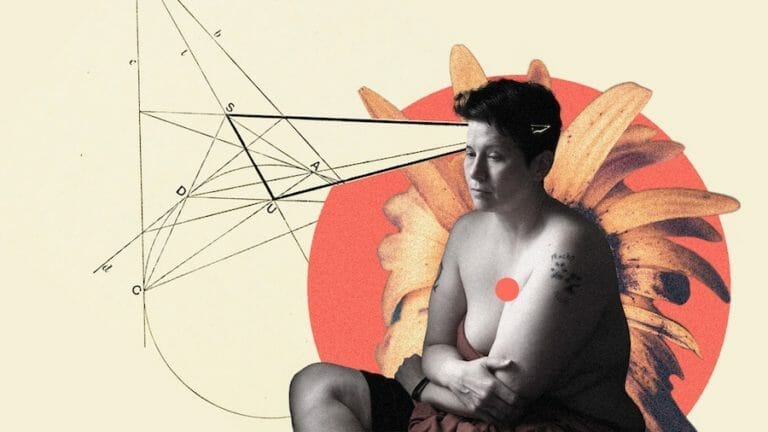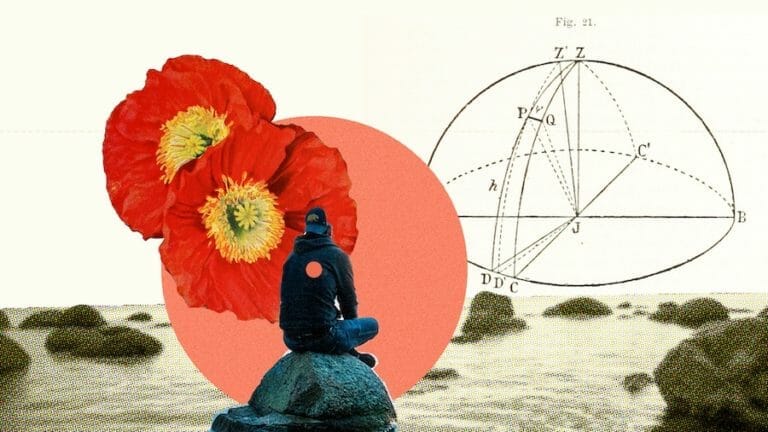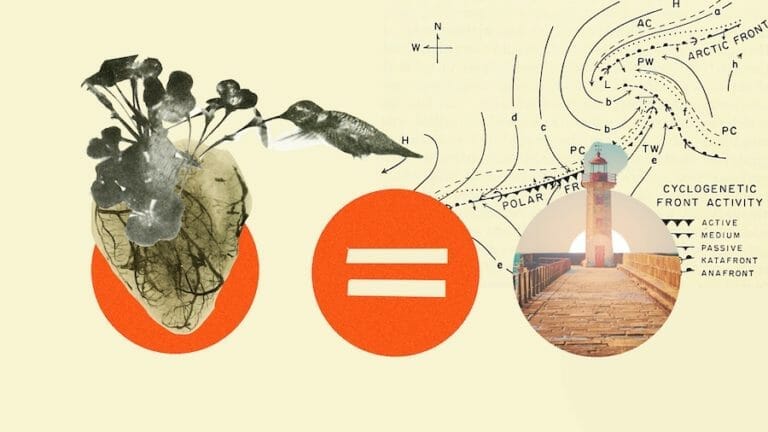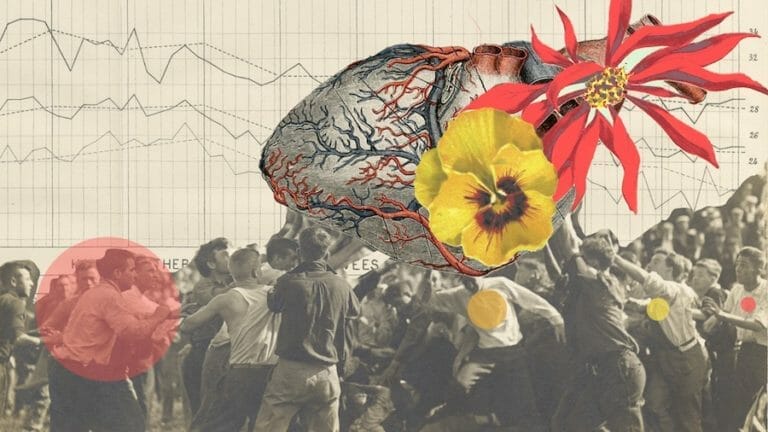The tantra tradition argues that most people don’t investigate the one aspect of their being; which is always there and always the same, which is awareness itself. Everything else changes. The only factor in every experience you’ve ever had is awareness. Yet, people don’t investigate the nature of this awareness and it comes as this incredible delightful surprise if, through spiritual practice, you investigate awareness and you find it is not neutral. It actually has these qualities of what we might call loving presence, meaning awareness.
It has this quality of being willing to meet whatever is arising and hold space for it. Awareness holds space for everything that arises and subsides with this quietly, implacably loving presence. Implacably meaning, it doesn’t lose its quality of loving presence, no matter what the experience is but, you don’t notice that because thoughts and feelings can be very loud and awareness is quiet. Awareness, per se, is incredibly quiet and still, and yet it’s the space within which all these loud experiences arise and subside.

So, that’s what you and everyone gets to check in their own experience. Have a moment of sort of pure consciousness, where pure consciousness just means awareness and being, and nothing else is happening even just for a few moments. It can go on longer, but all you need is a few moments to see and feel that awareness by its very nature is still, silent, loving presence.
Once you’re in touch with it, then you can start to identify with it. Which makes sense to identify with that and not everything else as your mental being, because it’s the only thing that’s always there. Awareness is always there. You don’t notice its beauty, stillness, or silence until you investigate it. That investigation, we might call meditation. Not the kind of meditation where you’re trying to attain an altered state of consciousness. You abide in what you fundamentally always are. If you succeed in that to some degree, then you can feel that all sound is taking place within this great, beautiful silence; all motion and activity is taking place within this great, beautiful stillness. It’s always there. Nothing can disturb it. Meaning to say, this loving presence of still, silent awareness is undisturbed even by the noisiest crowd.
That’s a way to put it to the test. You think you have a realization of the nature of awareness, and then something dramatic and unexpected happens and you completely lose touch with it. That would mean, according to the tradition, that you’re still mainly experiencing a mental construct of awareness rather than awareness itself.
Living from the space of awareness itself does not mean inaction
So, when you are abiding in awareness itself, anything can happen and you see it and experience it as an expression of that same awareness and you react however is appropriate. It doesn’t mean this is some state where you’re just passively doing nothing. You can react however is appropriate without ever needing to believe, or feel, that anything is other than the one divine consciousness.
So, if somebody breaks into my house, I’m going to call the police, even though I can experience that event and that person as equally an expression of divine consciousness. But, the response that’s appropriate in terms of the words and actions is different for different forms of divine consciousness, even though they’re all equally divine conscious.

Yeah. So, the heart with a capital “H” is identical to the core of being the essence of being, and this cannot be localized in one particular place. In the region of the physical heart, or at the base of that region, we can tune into our essence nature. But, that doesn’t mean it’s localized there.
Why do we tune into it there? Because all these emotions and energies happen here, we all experience that even though it’s not rational from the point of view of the mind. If you’re heartbroken, you feel actual pain here, even if there’s nothing wrong with the physical heart organ, but you’re feeling pain. That’s energy, right? And that’s the energetic heart, as opposed to the physical heart. It’s the heart of the subtle body, or energy body.
Return home to the heart’s nectar
And everyone experiences the energy body. They just don’t call it that usually. Also, if you experience intense joy, you can feel it as a sensation here. So, here we come to the main teaching about the heart. The tantric tradition is that we do this meditation on the so-called heart Lotus. You do an actual practice with this over and over again. You visualize that the heart center is like a Lotus that’s not yet blossomed, it’s closed up. You visualize it opening more and more, the pedals unfolding and unfurling. The idea here is everyone has the heart of God within them, but they don’t necessarily perceive it, and others don’t necessarily perceive it.
So, we have to do this inner work symbolized by opening the Lotus of the heart, until it’s fully open. Then we see what was there all along. So, here’s the other cool part of the metaphor. The wandering mind or wandering attention is symbolized by a honeybee. So, you know, attention and the mind just wanders all over the place, just like a bee wanders. The mind is always sort of in search of nectar in its wanderings, even if you’re not consciously aware of that. So, when the Lotus of the heart opens up, when you open up this heart region and experience it more fully, then the wandering bee of the mind catches the whiff of this beautiful Lotus and it comes to rest in the heart Lotus, because it’s so sweet, it’s so nectarian.

The reason a Lotus is chosen, not some other flower, is because the Lotus has a structure in the middle called the pericardium. It’s like a little landing pad for the bee. So, the image of the wandering mind coming to rest in the heart, the bee coming to rest in that Lotus and experiencing that sweet nectar. In this metaphor then, all the thoughts and feelings are part of the same heart region, but they’re more peripheral because all the different petals of the flower are these mental, emotional states. And in the center of the flower is essence nature, which is not a mental, emotional state because all mental, emotional states come and go. This doesn’t come and go. It’s there if you can tune into it.
And then the question becomes, well, how do we open that Lotus of the heart? Well, it needs attention. It needs love. It needs the metaphorical equivalent of water and sunlight. We have to be willing to take time, to turn our attention within, reverently. The attitude matters. You turn your attention within, in a spirit of curious investigation. Let me look into what I am, fundamentally; what I am on the level beyond words, beyond memories, beyond personality. That’s what makes that Lotus of the heart open up more and more. So, the idea is that the highest joy is the joy of simply being. The joy of existence itself.
It’s the ultimate miracle, just the fact we exist. When you’re abiding in the Lotus of the heart, in the center of your being, you can feel that. You can see that. You don’t feel like you need anything else, just to exist is such a miracle. It’s the greater part of all the joy you could possibly experience. And when you don’t experience it, you keep going like that wandering bee, looking for the sweetness of life; where’s the happiness, where’s the good stuff, I want more of that. And it wouldn’t occur to the mind that just abiding and being, just experiencing the fullness of being, just realizing the miracle of existence, could be that joyful. So, as you see, the heart is the central spiritual teaching in this tradition.
Abiding and being, again, doesn’t mean that you’re passive. You’re open to what life wants to do through you, but you no longer think you have to prove yourself. It doesn’t feel like there’s anything you have to do to validate your existence here. In other words, your worth is proven by your very existence. There’s no other proof necessary when you see what you actually are. You see that your very being generates value, the most value. So, anything else on top of that is just pure gravy.
You don’t need meditation, as formally conceived.
Yeah, exactly. It’s one way of saying that describing that realization is like the wonder and the joy of just contemplating that out of all of the things this universe could have become—infinite possibility—it has chosen to become you. It has chosen to become me. And at the deepest level, we are one being, looking out through two different pairs of eyes, looking out through two different body-minds. The difference is in the level of the body-mind that’s being looked through. And so, out of all the things the universe could have become, it’s chosen to become us. And you realize that, the implication of that is staggering.

What else do you need except to dwell in that fullness? And, you don’t need meditation, as formally conceived. We have to get past this idea of meditation as this kind of, “I’m going to discipline my mind, clear my mind of thoughts.” That kind of thing—there’s diminishing returns—let’s put it that way. It’s a struggle with the mind that you can win if you’re persistent enough, but it’s not the real deal. As far as the tantric tradition is concerned, it’s about just taking time to find your center. Investigate what feels like the center of your being, the innermost heart, and to just hang out there. So, meditation should rightfully be called, hanging out in the heart.
It’s just making time for that. As opposed to always running from one thing to the next, always doing your to-do list, always pursuing your agenda. Just making time for that. That kind of meditation can happen anywhere, any time. It’s maybe better to call it awareness cultivation.
The spirit of curiosity nourishes the heart’s flower
It’s like a positive feedback loop. This curiosity might seem to some people like a trivial point, but it’s a very important point because we usually look judgmentally to evaluate which thoughts are good or, or right, and which are bad or wrong. This judgmental evaluative mode prevents us from really nourishing that Lotus of the heart. And so, the counter to that is the spirit of curiosity. Whatever my mind says, that’s just a mental construct, “This thought is good, that one’s bad; I shouldn’t be having this feeling, or even, I don’t like this feeling.”

That’s the mind resisting a feeling by saying I don’t like it. But, then you ask, well, wait a second, is that really true? If ‘“I” means what I fundamentally am—not a thought—if ‘I’ is not a thought, is it really true that “I” don’t like this feeling? And you discover no, it’s that my mind is resisting the feeling. The mind doesn’t like to feel pain or sadness, but awareness itself meets everything with that same loving presence, that just equally shows up for everything.
Just noticing that, getting curious about that—awareness shows up for everything, including the mind’s resistance. So, it’s like the mind is saying, “I don’t like this feeling.” Awareness is okay with the feeling, and it’s okay with the mind resisting the feeling. Awareness itself is sort of quietly delighted by the whole thing, because everything expresses some aspect of existence, and existence itself is beautiful, fascinating and strange. So, this spirit of curiosity is such an important thing to cultivate to get past the judgmental self-examination.
Letting go vs. moving through
Here’s the interesting thing, when you’re resisting suffering it, you’re giving it more energy. There’s a saying, “Whatever you resist, persists.” So, what do you do with suffering? You do the same thing with it that you do with everything else, let it move through; which is different from pushing it away, or even letting it go. In spiritual circles, people like to say, “Just let it go.” No, no, no. When you say to yourself, “Let it go,” you’re usually just pushing it away. So, the deeper cue, or the more beneficial cue is to allow it to move through.
Really deal with it, but don’t impede its progress. So, for example, grief, if you lose someone you love, grief is an energy that moves through. If you let it, it moves through in waves. And if you realize what it truly is, you realize it’s love, that grief is love. It’s just the form that love takes when that person is not available to you anymore. And therefore, there’s beauty in it. There’s beauty in the grief, but grief is horrible if it gets sort of prolonged, if it overstays its natural cycle. It overstays when we resist it, or when we overly embrace it, right? Sometimes people don’t want to stop grieving because they think it would be a disservice to the person they’ve lost. So, they overly embrace it.
So, whether you’re pushing something away or grabbing onto it, you impede its natural progress. That’s what I mean by letting it move through, because what you are is the space of awareness that everything moves through. You start to see, “My gosh if I don’t push it away or grab onto it, every emotion moves, it wants to move.” That’s what it does. It flows.
